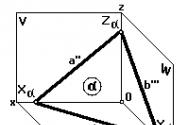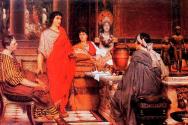Daphne Greek mythology. Myths and Legends * Apollo and Daphne
daphne, Greek ("laurel") - the daughter of the river god Peneus or Ladon, one of the most beautiful nymphs.
He fell in love with Daphne, but not because of beauty, but as a result of Eros' malicious joke. Apollo had the imprudence to laugh at the golden bow of the god of love, and Eros decided to demonstrate to him the effectiveness of his weapon. At Apollo, he shot an arrow that evokes love, and at Daphne, who happened to be nearby, he shot an arrow that kills love. Therefore, the love of the most beautiful of the gods did not find reciprocity. Pursued by God, Daphne began to beg her father to change her appearance, she was ready to die rather than become Apollo's lover. Daphne's wish came true: her body was covered with bark, her hands turned into branches, her hair into foliage. She turned into an evergreen laurel tree, while Apollo, in memory of his first love, began to wear a decoration in the form of a laurel wreath.

Apparently, the first poetic story about tragic fate Daphne belongs to Ovid (the first book of Metamorphoses). He inspired Bernini to create the famous sculptural group "Apollo and Daphne" (1622-1624), as well as Pollaiolo, Poussin, Veronese and many other artists - authors of paintings of the same name. Perhaps the very first of all operas, written by J. Peri to the text of the poet O. Rinuccini in 1592, was called Daphne. A number of further musical incarnations of this plot (Gagliano - 1608, Schutz - 1627, Handel - 1708) are closed by the opera "Daphne" by R. Strauss (1937).

As tradition testifies, the myth of Daphne existed long before Ovid (although, perhaps, in a slightly different version). At the place where, according to legend, Daphne turned into a tree, the temple of Apollo was built, which in 395 AD. e. was destroyed by order of Emperor Theodosius I, an opponent of paganism. Since pilgrims continued to visit the local laurel grove, in the 5th-6th centuries. n. e. a monastery was founded there with a temple of the Virgin Mary; the mosaic decorations of the temple, created in the 11th century, are one of the pinnacles of the "second golden age" of Byzantine art. This temple stands to this day in a green laurel grove ten kilometers west of Athens and is called "Daphni".
At that very wonderful moment, when, proud of his victory, Apollo stood over the monster Python he had slain, he suddenly saw not far from him a young rascal, the god of love, Eros. The prankster laughed merrily and also pulled on his golden bow. The mighty Apollo grinned and said to the kid:
- What do you need, child, such a formidable weapon? Let's do this: each of us will do our own thing. You go and play, and let me send the golden arrows. These are the ones I just slew this vicious monster. How can you equal me, archer?
Offended, Eros decided to punish the arrogant god. He slyly narrowed his eyes and answered the proud Apollo:
- Yes, I know, Apollo, that your arrows never miss. But even you can't escape my arrow.
Eros waved his golden wings and in the blink of an eye flew up to the high Parnassus. There he drew two golden arrows from his quiver. One arrow, wounding the heart and causing love, he sent to Apollo. And with another arrow that rejects love, he pierced the heart of Daphne, a young nymph, daughter of the river god Peneus. The little rascal did his evil deed and, fluttering with openwork wings, flew on. Time passed. Apollo had already forgotten about his meeting with the prankster Eros. He already had a lot to do. And Daphne continued to live as if nothing had happened. She still ran with her nymph friends through flowering meadows, played, had fun and did not know any worries. Many young gods sought the love of a golden-haired nymph, but she refused everyone. She didn't let any of them get close. Her father, old Peneus, was already saying to his daughter more and more often:
“When will you bring my son-in-law to me, my daughter?” When will you give me grandchildren?
But Daphne only laughed merrily and answered her father:
“Don't force me, my dear father. I don't love anyone and I don't need anyone. I want to be just like Artemis, an eternal maiden.
The wise Peneus could not understand in any way what had happened to his daughter. And the beautiful nymph herself did not know that the insidious Eros was to blame for everything, because it was he who wounded her in the heart with an arrow that killed love.
Once, flying over a forest glade, the radiant Apollo saw Daphne, and immediately the wound inflicted by the once insidious Eros came to life in his heart. Hot love flared up in him. Apollo quickly descended to the ground, not taking his burning eyes off the young nymph, and extended his hands to her. But Daphne, as soon as she saw the mighty young god, began to run from him as fast as she could. Amazed, Apollo rushed after his beloved.
“Stop, beautiful nymph,” he called to her, “why are you running away from me like a lamb from a wolf?” So the dove flies away from the eagle and the deer runs away from the lion. But I do love you. Be careful, this place is uneven, don't fall, I beg you. You hurt your leg, stop.
But the beautiful nymph does not stop, and Apollo implores her again and again:
- You yourself do not know, proud nymph, from whom you are running. After all, I'm Apollo, the son of Zeus, and not a simple mortal shepherd. Many call me a healer, but no one can heal my love for you.
In vain did Apollo cry out to the beautiful Daphne. She rushed forward, not understanding the road and not listening to his calls. Her clothes fluttered in the wind, her golden curls scattered. Her tender cheeks glowed a scarlet blush. Daphne became even more beautiful, and Apollo could not stop. He quickened his pace and was already overtaking her. Daphne felt his breath behind her, and she prayed to her father Peneus:
“Father, my dear! Help me. Part, earth, take me to you. Change my appearance, it causes me nothing but suffering.
As soon as she uttered these words, she felt that her whole body was numb, the tender girlish chest was covered with a thin crust. Her hands and fingers turned into branches of flexible laurel, green leaves rustled instead of hair on her head, light legs rooted into the ground. Apollo touched the trunk with his hand and felt his tender body still trembling under the fresh bark. He hugs a slender tree, kisses it, strokes the flexible branches. But even the tree does not want his kisses and avoids him.
For a long time, the saddened Apollo stood next to the proud laurel, and finally said sadly:
“You did not want to accept my love and become my wife, beautiful Daphne. Then you will become my tree. May the wreath of your leaves always adorn my head. And may your greenery never wither. Stay forever green!
And the laurel rustled softly in response to Apollo and, as if agreeing with him, bowed its green top.
Since then, Apollo fell in love with shady groves, where, among the emerald greenery, evergreen proud laurels stretched towards the light. Accompanied by his beautiful companions, young muses, he wandered here with a golden lyre in his hands. Often he came to his beloved laurel and, sadly bowing his head, fingered the melodious strings of his cithara. The enchanting sounds of music reverberated through the surrounding forests, and everything died down in rapturous attention.
But not for long Apollo enjoyed a carefree life. One day the great Zeus called him to him and said:
“You have forgotten, my son, about the order I have established. All who committed murder must be cleansed from the sin of shed blood. The sin of killing Python hangs over you too.
Apollo did not argue with his great father and convince him that the villain Python himself brought a lot of suffering to people. And by the decision of Zeus, he went to distant Thessaly, where the wise and noble king Admet ruled.
Apollo began to live at the court of Admet and serve him faithfully, atoning for his sin. Admetus instructed Apollo to graze the herds and look after the cattle. And since Apollo became a shepherd to King Admetus, not a single bull from his herd has been dragged away by wild animals, and his long-maned horses have become the best in all of Thessaly.
But one day Apollo saw that Tsar Admet was sad, did not eat, did not drink, walked completely drooping. And soon the reason for his sadness became clear. It turns out that Admet fell in love with the beautiful Alcesta. This love was mutual, the young beauty also loved the noble Admet. But Father Pelius, king of Iolka, set impossible conditions. He promised to give Alcesta as a wife only to those who come to the wedding in a chariot drawn by wild animals - a lion and boars.
The dejected Admet did not know what to do. And not that he was weak or cowardly. No, King Admet was powerful and strong. But he did not even imagine how to cope with such an overwhelming task.
“Don't be sad,” Apollo said to his master. “There is nothing impossible in this world.
Apollo touched Admet's shoulder, and the king felt his muscles fill with irresistible strength. Joyful, he went into the forest, caught wild animals and calmly harnessed them to his chariot. The proud Admet rushed to the palace of Pelias on his unprecedented team, and Pelias gave his daughter Alcesta as a wife to the mighty Admet.
Apollo served for eight years with the king of Thessaly, until he finally atoned for his sin, and then returned to Delphi. Here everyone is already waiting for him. The delighted mother, the goddess Leto, rushed to meet him. The beautiful Artemis rushed from the hunt as soon as she heard that her brother had returned. He climbed to the top of Parnassus, and here he was surrounded by beautiful muses.
Ancient Greek mythology is rich in curious characters. In addition to the gods and their offspring, legends describe the fate of mere mortals and those whose lives were connected with divine creatures.
Origin story
According to legend, Daphne is a mountain nymph, born in the union of the goddess of the earth Gaia and the river god Peneus. In Metamorphoses, he explains that Daphne was born to the nymph Creusa after a romantic relationship with Peneus.
This author held to the myth that he fell in love with a pretty girl after being pierced by an arrow from Eros. The beauty did not reciprocate, since the other end of the arrow made her indifferent to love. Hiding from the persecution of God, Daphne turned to her parent for help, who turned her into a laurel tree.
According to another writer, Pausanias, the daughter of Gaia and the god of the rivers Ladon, was transferred by her mother to the island of Crete, and a laurel appeared in the place where she was. tormented unrequited love, Apollo wove himself a wreath from the branches of a tree.
Greek mythology is famous for its variability of interpretations, therefore modern readers they also know the third myth, according to which Apollo and Leucippus, the son of the ruler Oenomai, were in love with the girl. The prince, dressed in a woman's dress, pursued the girl. Apollo bewitched him, and the young man went to bathe with the girls. For the deceit, the nymphs killed the prince.

Due to the fact that Daphne is associated with a plant, her independent destiny in mythology is limited. It is not known whether the girl subsequently became a human. In most references, she is associated with the attribute that accompanies Apollo everywhere. The origin of the name is rooted in the depths of history. From Hebrew, the meaning of the name was translated as "laurel".
The myth of Apollo and Daphne
The patron of the arts, music and poetry, Apollo was the son of the goddess Latona and. Jealous, the wife of the Thunderer did not give the woman the opportunity to find shelter. sent a dragon named Python after her, who chased Latona until she settled on Delos. It was a harsh uninhabited island that blossomed with the birth of Apollo and his sister. Plants appeared on the deserted shores and around the rocks, the island was lit up with sunlight.

Armed with a silver bow, the young man decided to take revenge on Python, who did not give his mother peace. He flew across the sky to the gloomy gorge where the dragon was located. A furious terrible beast was ready to devour Apollo, but the god hit him with arrows. The young man buried his rival and erected an oracle and a temple on the burial site. According to legend, today Delphi is located on this place.
Not far from the place of the battle, the prankster Eros flew by. The mischievous man played with golden arrows. One end of the arrow was adorned with a gold tip, and the other with lead. Boasting before the hooligan of his victory, Apollo invoked the wrath of Eros. The boy shot an arrow into the heart of God, whose golden tip evoked love. The second arrow with a stone tip hit the heart of the lovely nymph Daphne, depriving her of the ability to fall in love.

Seeing the beautiful girl, Apollo fell in love with her with all his heart. Daphne is on the run. God pursued her for a long time, but could not catch up. When Apollo came close, so that she began to feel his breath, Daphne prayed to her father for help. To save her daughter from torment, Peneus turned her body into a laurel tree, her hands into branches, and her hair into foliage.
Seeing what his love had led to, the inconsolable Apollo hugged the tree for a long time. He decided that a laurel wreath would always accompany him in memory of his beloved.
In culture
"Daphne and Apollo" is a myth that inspired artists of different centuries. He is one of the popular legends of the Hellenistic era. In ancient times, the plot was depicted in sculptures describing the moment of the transformation of a girl. There were mosaics that confirmed the popularity of the myth. Later painters and sculptors were guided by Ovid's exposition.

During the Renaissance, antiquity again received great attention. In the 15th century, the popular myth of a god and a nymph resonated in the paintings of the painters Pollaiolo, Bernini, Tiepolo, Brueghel and. Sculpture by Bernini in 1625 was placed in the cardinal residence of Borghese.
In literature, the images of Apollo and Daphne are repeatedly mentioned thanks to. In the 16th century, the works "Princess" by Sax and "D." authorship of Beccari, which are based on mythological motifs. In the 16th century, Rinuccini's play Daphne was set to music and, like the works of Opitz and, became an opera libretto. Inspired by a story of unrequited love, musical works wrote Schutz, Scarlatti, Handel, Fuchs and.
Many mythical characters of antiquity were reflected in works of art - paintings, sculptures, frescoes. Apollo and Daphne are no exception, they are depicted in many paintings, but great sculptor Giovanni Lorenzo Bernini even created a sculpture that is famous all over the world. The story of a god unrequitedly in love is striking in its tragedy and remains relevant to this day.
Legend of Apollo and Daphne
Apollo was the god of art, music and poetry. According to legend, once he angered the young god Eros, for which he shot an arrow of love at him. And the second arrow - antipathy - was launched by Eros in the heart of the nymph Daphne, who was the daughter of the river god Peneus. And when Apollo saw Daphne, at first sight love for this young and beautiful girl ignited in him. He fell in love and could not take his eyes off her extraordinary beauty.
Struck in the heart by the arrow of Eros, Daphne felt fear at first sight and inflamed with hatred for Apollo. Not sharing his feelings, she rushed to run away. But the faster Daphne tried to escape from her pursuer, the more insistent was Apollo in love. At that moment, when he almost overtook his beloved, the girl pleaded, turning to her father and asking for help. The moment she screamed in despair, her legs began to stiffen, rooted to the ground, her hands turned into branches, and her hair became leaves of a laurel tree. Disappointed Apollo could not come to his senses for a long time, trying to accept the inevitable.
History embodied in art
Apollo and Daphne, whose story strikes with despair and tragedy, inspired many great artists, poets, sculptors throughout history. Artists tried to depict running on their canvases, sculptors tried to convey the power of love and awareness of their own impotence of the young god Apollo.
A well-known work that reliably reflects the tragedy of this story was the canvas of A. Pollaiolo, who in 1470 painted a picture with the same name “Apollo and Daphne”. Today, it hangs in the London National Gallery, drawing the eyes of visitors with the realism of the characters depicted. Relief is read on the girl's face, while Apollo is saddened and annoyed.

A prominent representative of the Rococo style, Giovanni Battista Tiepolo, even depicted in his painting “Apollo and Daphne” the girl’s father, who helps her avoid the pursuer. However, despair is read on his face, because the price of such deliverance is too high - his daughter will no longer be among the living.
But the most successful work of art based on the myth can be considered the sculpture of Giovanni Lorenzo Bernini "Apollo and Daphne". Its description and history deserve special attention.
Sculpture by Giovanni Bernini
The great Italian sculptor and architect is deservedly considered the genius of the Baroque, his sculptures live and breathe. One of the greatest achievements of G. Bernini, "Apollo and Daphne", is the early work of the sculptor, when he was still working under the auspices of Cardinal Borghese. He created it in 1622-1625.
Bernini managed to capture the moment of despair and the way Apollo and Daphne move. The sculpture fascinates with its realism, the runners are in unison. Only in a young man is a desire to take possession of a girl, and she seeks to slip out of his hands at any cost. The sculpture is made of Carrara marble, its height is 2.43 m. The talent and dedication of Giovanni Bernini allowed him to complete a masterpiece of art in a relatively short time. Today the sculpture is in the Borghese Gallery, in Rome.
The history of the sculpture
Like many other sculptures, the sculpture "Apollo and Daphne" by Giovanni Bernini was commissioned by the Italian Cardinal Borghese. The sculptor began working on it in 1622, but he had to stop for a more urgent assignment from the cardinal. Leaving the statue unfinished, Bernini set to work on David, and then returned to his interrupted work. The statue was completed 3 years later, in 1625.

To justify the presence of a sculpture with a pagan bias in the cardinal's collection, a couplet was invented to describe the moral of the depicted scene between the characters. Its meaning was that the one who runs after the ghostly beauty will be left with only branches and leaves in his hands. Today a sculpture depicting final scene short-term relationship between Apollo and Daphne, stands in the middle of one of the halls of the gallery and is its thematic center.
Features of the created masterpiece
Many visitors to the Borghese Gallery in Rome note that the sculpture causes an ambiguous attitude towards itself. You can look at it many times, and each time find something new in the features of the depicted gods, in their frozen movement, in the general concept.

Depending on the mood, some see love and a willingness to give everything for the opportunity to have a beloved girl, others note what relief is depicted in the eyes of a young nymph when her body turns into a tree.
The perception of sculpture also changes depending on the angle from which it is viewed. No wonder it was placed in the center of the gallery hall. This gives each visitor the opportunity to find their own point of view and form their own vision of the great masterpiece.
Boris Vallejo - Apollo and Daphne
When the bright god Apollo, proud of his victory over Python, stood over the monster slain by his arrows, he saw near him the young god of love Eros, pulling his golden bow. Laughing, Apollo said to him:
- What do you need, child, such a formidable weapon? Leave it to me to send out the smashing golden arrows with which I just killed Python. Are you equal in glory with me, the archer? Do you want to achieve more fame than me?
Offended, Eros proudly answered Apollo:
- Your arrows, Phoebus-Apollo, do not know a miss, they will smash everyone, but my arrow will hit you too.
Eros waved his golden wings and in the blink of an eye flew up to the high Parnassus. There he took out two arrows from the quiver: one - wounding the heart and causing love, he pierced the heart of Apollo with it, the other - killing love, he launched into the heart of the nymph Daphne, the daughter of the river god Peneus and the goddess of the earth Gaia.
Apollo and Daphne - Bernini
Once I met the beautiful Daphne Apollo and fell in love with her. But as soon as Daphne saw the golden-haired Apollo, she started to run with the speed of the wind, because the arrow of Eros, which kills love, pierced her heart. The silver-eyed god hurried after her.
- Stop, beautiful nymph, - he cried, - why are you running from me, like a lamb pursued by a wolf, like a dove fleeing from an eagle, you are rushing! After all, I'm not your enemy! Look, you hurt your legs on the sharp thorns of the blackthorn. Oh wait, stop! After all, I am Apollo, the son of the Thunderer Zeus, and not a simple mortal shepherd.
But the beautiful Daphne runs faster and faster. As if on wings, Apollo rushes after her. He is getting closer. Now it's coming! Daphne feels his breath, but her strength leaves her. Daphne prayed to her father Peneus:
- Father Peney, help me! Part quickly, mother earth, and devour me! Oh, take away this image from me, it causes me only suffering!
Apollo and Daphne (Jakob Auer)
As soon as she said this, her limbs immediately became numb. The bark covered her delicate body, her hair turned into foliage, and her hands raised to the sky turned into branches.
Apollo and Daphne - Carlo Maratti, 1681
For a long time the sad Apollo stood in front of the laurel and, finally, he said:
“Let a wreath of only your greenery decorate my head, let from now on you decorate with your leaves both my cithara and my quiver. May your greenery never wither, O laurel, Stay forever green!
The laurel quietly rustled in response to Apollo with its thick branches and, as if in a sign of consent, bowed its green top.
-
Kun N.A., Neichardt A.A. "Legends and myths Ancient Greece and Ancient Rome "- St. Petersburg: Litera, 1998








